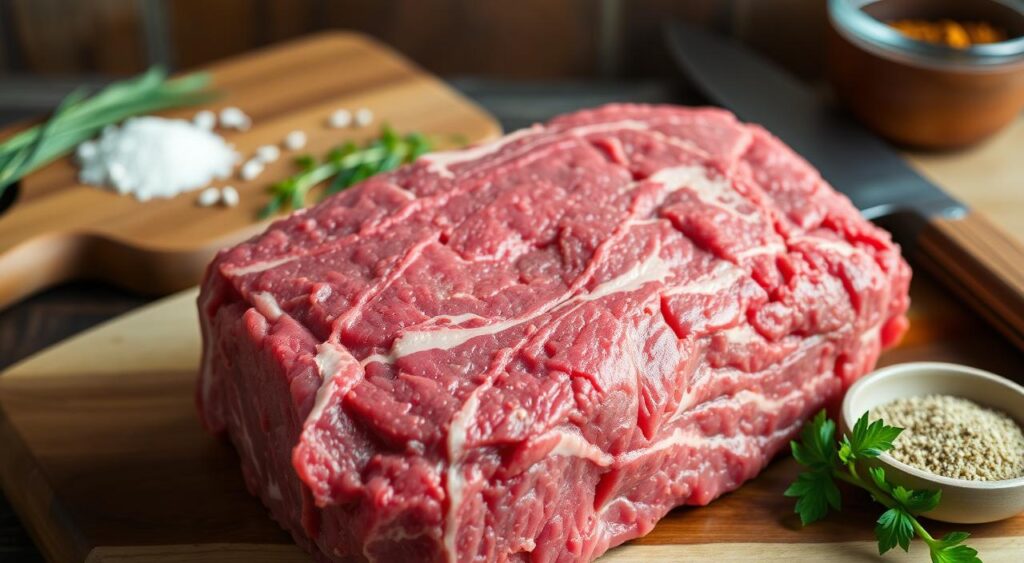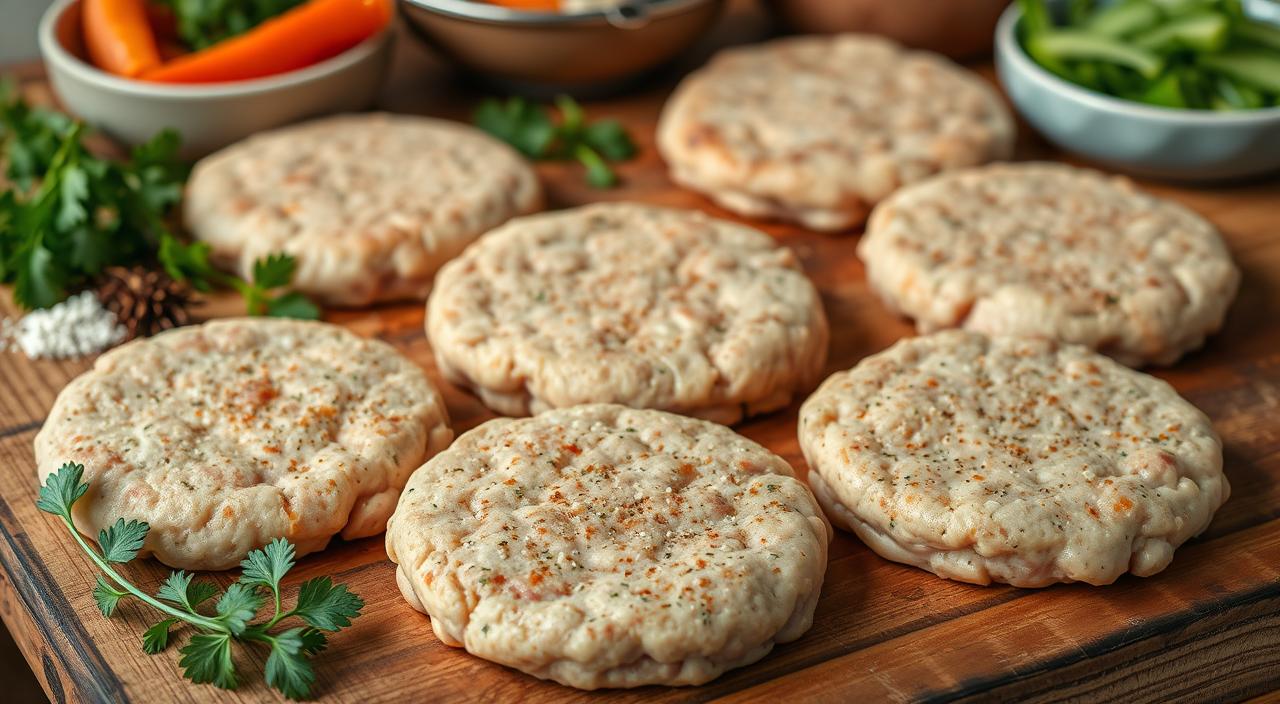The humble patty is a classic American favorite, holding a special place in our hearts and on our plates. I remember the mouthwatering aroma of sizzling patties at backyard barbecues, making my taste buds dance with excitement.
Today, I’m excited to share my secrets for making the most delicious homemade patties. They will make your family and friends rave.
Whether you’re a seasoned grillmaster or new to the kitchen, this guide will help you. You’ll learn how to pick the perfect ground beef and shape and cook your patties. You’ll make juicy, flavorful homemade patties that will impress everyone.
Get ready to enjoy burgers so good, they’ll take you back to those summer memories.
Essential Ingredients for Perfect Hamburger Patties

Making the perfect homemade hamburger patty begins with choosing the right ingredients. Start with high-quality ground chuck. It has an 80/20 lean-to-fat ratio for juicy, flavorful burgers. For binders, use crushed crackers or Panko breadcrumbs. They help the patty stay together and add texture.
Ground Meat Selection and Fat Ratio
For juicy, flavorful burgers, choose ground chuck with an 80/20 lean-to-fat ratio. This ratio keeps your patties moist and tender. It also prevents them from getting too greasy. Aim for 15-20% fat content in your ground beef for the best burger experience.
Binding Ingredients and Seasonings
The ground chuck is the main ingredient, but a few binders and seasonings can elevate your patties. Use crushed crackers or Panko breadcrumbs as binders. For seasonings, salt, garlic powder, onion powder, and black pepper are must-haves. Adding Worcestershire sauce can also enhance flavor.
Optional Flavor Enhancers
Experiment with flavor enhancers to make your burger unique. Try red pepper flakes, cumin, chili powder, fresh parsley, or dill. These can add special touches to your patty. Mix different spices to create your own signature flavor.
“The key to the perfect homemade burger is finding the right balance of ground chuck, binders, and seasonings to achieve that mouthwatering texture and flavor.” – Chef Alex, Burger Aficionado
The Secret to Juicy Patties: Proper Mixing Techniques

Making the perfect burger begins with mixing your hamburger mix right. It’s all about finding the perfect balance. You want to mix well but avoid overworking, which can make patties dry and dense.
Start by mixing the ground meat, seasonings, and any extra ingredients with your hands. Don’t overdo it, as this can make the meat tough. You’re aiming for a mix that’s smooth but not overworked.
“The secret is in the handling – you want to be gentle but thorough when mixing the burger ingredients. Overwork the meat and you’ll end up with a dense, dry patty.”
After mixing, press the hamburger mix into a flat disk. Then, divide it into portions and shape each into a patty. Make sure the patties are a bit bigger than your buns to shrink a bit during cooking. For thicker patties, make a small dent in the middle to prevent them from puffing up.
With a bit of practice in gentle mixing techniques, you’ll soon be making juicy patties that everyone will love.
Tools and Equipment for Shaping Perfect Patties
Making the perfect homemade burger starts with the right tools. Professional burger presses are convenient, but you can also use DIY methods. Repurposing common items like jar lids as patty molds is a smart idea.
Using Jar Lids as DIY Patty Molds
Jar lids are great for making DIY patty molds. Just line the lid with plastic wrap to stop the meat from sticking. Then, press the ground meat into the lid to form uniform patties.
This method works for all patty sizes, even sliders. The meat should be chilled to prevent it from sticking and to make shaping easier.
Professional Burger Presses vs. Home Solutions
Professional burger presses are sleek and efficient but can be pricey. Basic models, however, cost under $10 and are a good choice for home cooks. These presses are made from durable materials and help shape patties of different sizes.
When using a burger press, choose ground meat with at least 20% fat for better taste and texture. Freshly ground meat on the day of cooking will also give the best results.
Step-by-Step Patty Formation Guide
Making the perfect homemade hamburger patties is an art. Start by lining a baking sheet with wax paper or foil. This makes shaping your patties easy. Then, get your patty mix ready, whether it’s fresh beef or a mix of your choice.
For patty formation, press the meat firmly into your shape and thickness. Make patties a bit bigger than your buns to shrinkage. For thicker patties, create a dent in the middle for even cooking.
Stack hamburger patties with wax paper in between to prevent sticking. This makes cooking each patty separately easy. Refrigerate your patties for at least an hour before cooking. This step lets flavors mix and patties firm up, making them juicier.
Follow these tips to make perfect homemade burgers every time. Enjoy the tasty results of your hard work!
Temperature and Timing: Keys to Perfect Cooking
To get your homemade burger patties just right, you need to know about temperature and cooking time. Whether you grill, sear on the stovetop, or bake in the oven, it’s crucial to understand the right grilling temperature, cooking duration, and burger thickness. This will lead to delicious results every time.
Optimal Grilling Temperatures
For grilling, preheat your grill or skillet to medium heat, between 350-400°F. This temperature helps the outside sear and caramelize while keeping the inside juicy and full of flavor. For thicker patties, grill for 3-4 minutes on each side, flipping only once or twice.
Cooking Duration for Different Thicknesses
The thickness of your burger patties affects cooking time. Thin patties, about ¾-inch thick, cook faster, usually 2 minutes per side. Thicker patties, over 1 inch, take 3-4 minutes per side to cook to your liking. Always check with a meat thermometer to ensure the perfect internal temperature, whether you like them rare, medium-rare, or well-done.
Remember, juicy, perfectly cooked burgers depend on more than just grilling temperature and cooking time. The burger thickness also plays a big role. By mastering these elements, you’ll make the ultimate homemade patties every time.
Grilling vs. Stovetop Methods
There are two main ways to cook a great burger: grilling or using the stovetop. Both methods make tasty burgers, but they have different benefits and things to consider.
Grilling gives your burgers a smoky taste and those cool grill marks. The grill’s high heat sears the outside quickly, keeping the juices inside. To stop the burgers from puffing, make a small dent in the middle of thick patties before grilling.
Using a cast-iron skillet on the stovetop is ideal. It cooks the burgers evenly, making the outside crispy. Cook the patties over medium heat for 3-4 minutes on each side. Make sure not to put too many in the pan at once.
“Experiment with both grilling burgers and stovetop methods to discover your preferred technique and find the one that best suits your needs and taste preferences.”
Choose between the smoky taste of the grill or the crispy sear of the stovetop. The most important thing is to find the method that works best for you. With a bit of practice, you’ll make perfect homemade burgers every time.
Alternative Patty Varieties
Beyond the classic beef patty, there’s a world of flavors to explore. From veggie patties to seafood and poultry, the choices are endless. These options cater to different diets and offer new tastes to try.
Veggie Patties and Plant-Based Options
Veggie patties have evolved, with Impossible Burgers and Beyond Burgers becoming favorites. They aim to replicate the taste and feel of beef, appealing to all. Black bean, quinoa, and chickpea burgers are also great, full of fiber, protein, and nutrients.
Seafood and Poultry Variations
Looking for something other than beef? Seafood and poultry patties are tasty alternatives. Salmon and crab cakes add omega-3s and lean protein. Turkey, chicken, and pork burgers offer lower-fat options and variety.
Trying these patties can make your burger menu more interesting. They’re perfect for health-conscious diners or anyone looking to try something new. Whether you’re a vegetarian or just curious, these patties are worth a taste.
Storage and Make-Ahead Tips
To enjoy your homemade hamburger patties for days, proper storage is key. Cooked patties can be stored in an airtight container in the fridge for up to 3 days. For longer storage, freeze uncooked or cooked patties for up to 3 months.
Wrap each patty in plastic wrap and put them in a freezer bag before freezing. When you’re ready, thaw the patties in the fridge overnight before cooking.
For the best results, form your patties and refrigerate them for at least 1 hour before cooking. This helps them firm up and hold their shape better. Making patties ahead of time can save you time on busy weeknights.
Whether you store cooked or uncooked patties, these tips will keep your burgers juicy and flavorful. You’ll have them ready to grill or sear whenever you want.
FAQ
What is the ideal ground meat selection and fat ratio for homemade patties?
For the juiciest patties, choose 80/20 ground chuck. This mix of 80% lean meat and 20% fat is perfect for flavor and moisture.
What binding ingredients and seasonings are essential for homemade patties?
You’ll need crushed crackers or panko breadcrumbs as binders. Don’t forget salt, garlic powder, onion powder, and pepper. Worcestershire sauce adds a rich flavor.
How do I properly mix the patty ingredients to achieve a smooth, consistent texture?
Mix the ingredients by hand until they’re smooth. But don’t overmix to avoid a dense texture. Press the mixture into a disk before shaping patties.
What tools and equipment can I use to shape uniform patties at home?
Use jar lids as a DIY patty mold. Cover the lid with plastic wrap for easy removal. While professional burger presses are available, jar lids are a cost-effective option.
How should I prepare the patties before cooking for the best results?
Make patties slightly larger than the buns to shrink during cooking. For thick patties, create a dent in the center. Refrigerate the patties for at least 1 hour before cooking.
What are the optimal cooking temperatures and times for grilling and stovetop cooking?
Heat your grill or skillet to medium (350-400°F). Grill or fry thick patties for 3-4 minutes per side. Thin patties need only 2 minutes per side. Flip burgers once or twice during cooking.
What are the differences between grilling and stovetop cooking methods for burgers?
Grilling adds smoky flavor and grill marks. Stovetop cooking in a cast-iron skillet creates a caramelized sear. Both methods are delicious, so try them out.
What alternative patty varieties can I explore beyond traditional ground beef?
Try veggie patties made from beans, grains, and veggies. Plant-based options like soy and Beyond Meat are also great. For poultry, seasoned ground turkey patties are tasty. Seafood options include salmon patties and crab cakes.
How can I store and prepare homemade patties in advance?
Cooked patties can be stored in the fridge for up to 3 days. Freeze uncooked or cooked patties for up to 3 months. Thaw frozen patties in the fridge overnight. For best results, form patties and refrigerate for at least 1 hour before cooking.
